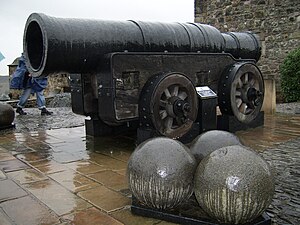Mons Meg
| Mons Meg | |
|---|---|

Mons Meg with its 20" (510 mm) calibre cannon balls
|
|
| Type | Cannon |
| Place of origin | Mons, Hainault, Wallonia |
| Service history | |
| Used by |
• |
| Production history | |
| Designer | Jehan Cambier |
| Produced | June 1449 |
| Specifications | |
| Weight | 6.6 t |
| Length | 406 cm |
| Barrel length | 280 cm |
|
|
|
| Shell weight | 175 kg |
| Caliber | 510 mm (ball diameter) |
Mons Meg is a medieval bombard located at Edinburgh Castle in Scotland. It was built in 1449 on the orders of Philip the Good, Duke of Burgundy and sent by him as a gift to James II, King of Scots in 1454. The bombard was employed in sieges until the middle of the 16th century, after which it was only fired on ceremonial occasions. It was on one such occasion in 1680 that the barrel burst, rendering Mons Meg unusable. The gun remained in Edinburgh Castle until 1754 when, along with other unused weapons in Scotland, it was taken to the Tower of London. Sir Walter Scott and others campaigned for its return, which was effected in 1829. Mons Meg has since been restored, and is now on display within the castle. Mons Meg has a calibre (barrel diameter) of 20 inches (510 mm), making it one of the largest cannons in the world by calibre. The gun forms part of the collection of the Royal Armouries, on loan to Historic Scotland who manage Edinburgh Castle.
The bombard was manufactured from longitudinal bars of iron, hooped with rings fused into one mass. The barrel is attached to the powder chamber by means of a groove on the powder chamber into which lugs on the end of the barrel staves fit, and then bound permanently together by the hoops. The powder chamber itself is made from small pieces of iron hammer welded together to make a solid wrought-iron forging. Mons Meg weighs 15,366 pounds (6,970 kg), is 15 feet (4.6 m) in length, and has a calibre of 20 inches (510 mm). The final cost of the gun was £1,536. 2s.
Mons Meg was constructed by Jehan Cambier, artillery maker to the Duke of Burgundy, and it was successfully tested at Mons in the County of Hainault on what is now the France-Belgium border in June 1449; however, the Duke did not take delivery of the Mons Meg until 1453. Desiring to "interfere in English affairs", the Duke decided to help the Scots against the English. It was given to James II in 1454.
...
Wikipedia
